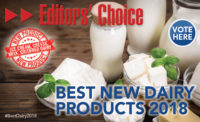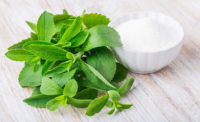Colors for dairy products are going natural
Given dairy products’ health halo, natural colors are a natural fit.

“It isn’t easy being green,” Kermit the Frog famously said. And from a dairy product perspective, it’s not easy being any color that fails to resonate with today’s consumers.
What does boast appeal among many of today’s consumers is a color that is “natural.” Although no formal definition exists, the dairy industry considers a natural color to be one produced from natural sources instead of synthetic sources, according to Carol Locey, director of product management – colors for Kalsec Inc., Kalamazoo, Mich. FDA allows the use of certified colors (all synthetically produced) or non-certified colors (most, but not all of which are derived from natural sources).
Technically, the correct terminology for what is commonly referred to as natural is “color additives exempt from batch certification,” clarifies Sanford “Sandy” Golden-Dukes, director of business development and operations for IFC Solutions, Linden, N.J. However, that phrase would not cut the mustard when it comes to product marketing.
“So most people use ‘natural’ for shorthand, as it conveys the message consumers want to hear: ‘no synthetic or FD&C colors,’” he explains.
In reality, the definition of natural really depends on the customer, says Jeff Greaves, founder and manager of Food Ingredient Solutions LLC, Teterboro, N.J.
“For example, beta-carotene can be extracted from algae, made by fermentation or synthesized,” he explains. “The label declaration is the same, and most customers use the synthetic material. However, some require natural, and some will not even accept material made by fermentation as natural.”
Natural colors a natural fit
Given dairy products’ health halo, natural colors are a natural fit.
“Natural products in dairy manufacturing are primarily products that have no chemical associations, are less processed and originate from natural sources,” says Christiane Lippert, head of marketing (food) for Lycored, Branchburg, N.J. “Additionally, customers [have] far more understanding of the ingredients put into products, so the dairy industry has seen an increase in customers wanting traceability of the products they purchase.”
Natural pigments commonly used in dairy applications include carotenoids and anthocyanins, according to research & development (R&D) team experts with Roha USA LLC, St. Louis. For example, carotenoids such as annatto, paprika and beta-carotene impart varying shades of orange and yellow in cheese applications. And anthocyanins extracted from fruit and vegetable sources add color in lower-pH applications such as yogurt and fermented beverages.
“Roha’s portfolio contains natural colors with pigments that cover a wide spectrum of colors that are suitable to be applied in dairy applications like yogurt, fermented beverages, ice cream, flavored dairy beverages, plant-based beverages, cheese and processed cheese,” the team notes. “We also offer the Futurals brand, which has different coloring foods extracted from vegetable and fruit sources and can be used to offer clean-label products.”
Meghan Fox, marketing specialist with Sensient Food Colors, St. Louis, says consumers prefer colors derived from botanical sources when seeking out clean ingredients and natural products.
“Colors derived from fruit and vegetable sources are very popular,” she says. “Of note is that consumers are interested in natural brown caramel alternatives. Our Sienna fruit juice has been popular in that regard. Other clean-ingredient color sources in dairy include beet- and spirulina-derived colors.”
Braden Hocking, associate application scientist for Chr. Hansen, Milwaukee, agrees that there is strong interest in these types of clean-label colors.
“Like our FruitMax technology, clean-label colors are minimally processed concentrates that are consumer-friendly — often declared as fruit or vegetable juice on ingredient labels,” he says.
For its part, Tarrytown, N.Y.-headquartered GNT USA Inc. offers Exberry coloring foods, comprising colors made from vegetables, fruit and edible plants, says Marty Gil, key account manager for the company. The coloring foods are made without chemical solvents via physical processing methods such as chopping and boiling.
“For us, this speaks directly to the core principle of clean labeling: that consumers should not only be able to understand ingredient lists, but also feel reassured when they read them,” he says. “Our colors can be described on the ingredient list in a simple way such as ‘fruit and vegetable juice for color’ or ‘carrot juice for color,’ so they fit perfectly with what consumers want. We’ve also developed a ‘Colored with Fruit & Vegetables’ logo, which can be added to the front of packaging to instantly communicate a product’s clean-label credentials.”
Not always a cinch
Working with natural colors is not necessarily easy, however. Many such colors are not stable over a varied pH range, Lippert says. And some do not perform well when exposed to light or in high-temperature processes processors typically use for flavored milks and other longer-shelf-life products.
“Some can also migrate significantly,” she notes. “This is particularly true for the fruit preparation layers in yogurts.”
Lippert says Lycored’s lycopene-based colors do not migrate in such yogurt applications.
“Lycopene is pH-neutral and shows high capability to withstand processing in challenging areas such as UHT [ultra-high-temperature] processing,” she says. “Our ConstantCrimson A and ResoluteRuby A are ideal options for red berry-flavored milks, withstanding UHT processing conditions and light exposure.”
Chr. Hansen also offers technologies to prevent color migration in fruit-on-the-bottom yogurts, Hocking says. And the company’s CapColors technology can help processors that are using anthocyanins — which can tend to shift blue and fade more quickly.
“Our CapColors technology — which improves pigment stability, increases color potency and enables pigments to retain their natural brightness — is widely used in the dairy industry to prevent color migration in bi-layer products and stabilize pigments through high-heat-processing parameters,” he explains.
Since many dairy applications are aqueous in nature, they require water-soluble colors, Locey points out.
“Paprika and carrot oleoresins are naturally oil-soluble but can be formulated as emulsions to provide water-dispersible yellow and orange hues for dairy beverages, yogurts and ice cream,” she says. “The organic dairy market is expected to continue to see strong growth over the next few years. Kalsec works closely with their customers to supply certified organic formulations of paprika and annatto.”
For its part, Downers Grove, Ill.-based Flavorchem developed concentrated natural extracts that allow processors to color various dairy products while meeting the clean-label trend, says Rebecca Shurhay, marketing analyst for the company.
“The benefit with these is the concentrated form, clean-label status and brilliant color profile,” she points out. “We have the ability to customize these to work optimally within a customer’s product.”
A natural but vivid red
Attaining a vivid red (or vivid pink) via a natural colorant is a processor challenge cited by many color suppliers.
“Dairy products tend to have a relatively short shelf life, but their typical pH eliminates some colors such as anthocyanins from most applications,” Greaves explains. “Sometimes it is a challenge to find a good red that is heat-stable enough for hot fill applications. We have a new, more heat-stable red beet color which can tolerate more heat abuse.”
Roha’s Natracol Rose Pink color, new for 2020, boasts excellent heat and light stability, too, the Roha R&D team notes. It can be used in pasteurized, UHT and retorted dairy applications without processors having to worry about fading. It is suitable for dairy processors that want to replace carmine and synthetic colors but still attain vibrant red and pink shades.
And Sensient’s SupraRed color technology offers another solution for these bright colors. Although beet is a good natural choice for bright red and pink shades in refrigerated dairy applications, it is inclined to brown during heat processing. Heat-stable and beet-based, the SupraRed technology results in “vivid red shades in neutral-pH environments,” according to Alexandra Sirosky, dairy technical service manager.
IFC Solutions also helps processors with the natural-color versus bright-red-color dilemma, Golden-Dukes says.
“We have developed special blends that achieve that bright red shade at neutral pH while still also being able to tolerate ultra-high temperatures without degrading,” he adds.
Caramel colors go non-GMO
Non-GMO offerings are of strong interest, too. Sethness Roquette, Skokie, Ill., now has 13 liquid and Class IV Non-GMO Project Verified caramel color offerings, notes Brian Sethness, executive vice president of sales and marketing – Americas.
“These are more expensive offerings than our typical caramel colors, but consumers — especially on the West Coast — like to see the ‘butterfly’ on product labels,” he says.
Still, Class I (plain) caramel colors are the fastest-growing caramel color segment, Sethness says, because they meet consumer demand for cleaner labels. The drawback? They can attain only a certain level of darkness, what he calls a light brown shade.
Still a (small) place for artificial
Despite strong demand for natural colors, artificial colors still have their place. In many cases, their use is tied to cost constraints.
“In cheese and processed cheese applications, usage of artificial colors such as Yellow 5 and Yellow 6 is widely popular,” the Roha R&D team points out. “However, other applications like ice cream, yogurt and flavored drinks are moving rapidly towards using natural colors.”
Because consumers view the dairy aisle as “very pure and natural,” artificial colors are really on their way out, says David Rigg, global marketing director for Sensient Food Colors. That said, he does note that a significant portion of the population still “is very happy with artificial colors.” So the natural-color versus artificial-color decision should be based on the consumer target rather than the product type.
And when it comes to dependability, FD&C colors are still the best option, Golden-Dukes stresses.
“They’re less expensive, more concentrated and easier to work with,” he says. “We still get a good bit of interest on new projects with these, even though most requests we get are for natural and organic colors.”
Still, Sethness points to a strong desire within the dairy space to remove all FD&C dyes. He adds that the International Technical Caramel Color Association does not have market information differentiating the caramel color market between “natural” and “artificial.”
Looking for a reprint of this article?
From high-res PDFs to custom plaques, order your copy today!








